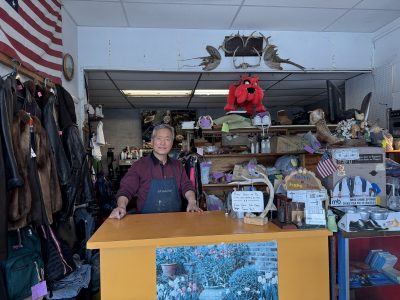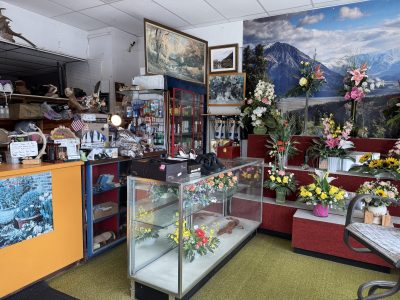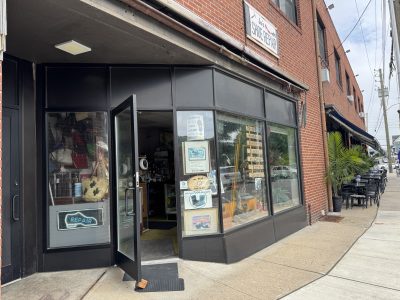Pleasantville’s Shoe ‘Magician’ Helps Soles—and the Planet
News Based on facts, either observed and verified directly by the reporter, or reported and verified from knowledgeable sources.

By Elaine Clarke
A regular strolls into Jo’s Shoe Repair on Cooley Street in Pleasantville, two bags in hand.
“You’re a magician, but—” she began.
Pulling a black-strapped wedge from one of the bags, she gestures to tears along the strap. Her puppy, she explains, was the culprit.
The gears are already turning in Yun Su Jo’s head. He knows he can fix it.
It’s not magic, he later joked, it’s muscle.
Jo has been repairing shoes—and more—for more than three decades. He learned the trade from a friend and opened his Pleasantville shop in the Cooley Street location after the community’s previous cobbler retired when business soured.
The Yonkers resident also fixes pocketbooks, belts, and other goods. In one corner of the shop, a stand displays neatly arranged flowers in vases for sale.
“Many, many things I try, now I try the flower,” Jo said. “This is extra business. My main business is the shoes.”

Quality of Shoes
Over the years, Jo has noticed more shoes made from cheaper materials like vinyl and plastic. He says that although higher-quality shoes cost more, they’re stronger, last longer, and create less waste.
“If they buy the cheap shoes. They buy the $10 just one time. Use, broken, problem,” explained Joe, who immigrated to America in 1982 from South Korea. “They’re gonna bring here, I say fix cost $10. They choice, throw it away or fix? Some people fix. Some people throw it away.”
Though some struggle to understand the cost, Jo points out that the shoe’s price doesn’t change the effort his work requires.
“I’m gonna fix the cheap price shoes or some expensive shoes, I’m gonna charge it as the same price,” he noted.
Jo explained that glue is one of the best materials for mending shoes. However, when customers bring in cheaper shoes made of plastic rather than natural materials, those shoes often respond inconsistently to the same adhesive.
Jo explained glue is one of the best materials to use when mending shoes. But with cheaper plastic shoes, compared to those made from natural materials, the glue doesn’t always work the same way.

“This is kind not 100% guarantee,” he said.
History Lesson
With the rise of fast fashion, shoes have become easier to toss and replace, leading to more waste piling up in landfills—where they’ll take thousands of years to decompose.
Director and Senior Curator Elizabeth Semmelhack of the Bata Shoe Museum in Toronto explained in an email to The Examiner that shoemaking and cobbling were once distinct professions—until shoe production became industrialized in the 19th century, leading many shoemakers to become cobblers. She added that the rise of fast fashion and mass shoe production has caused the value of repair work to decline.
“Not only are many fast fashion shoes poorly made, meaning that repair isn’t even possible, but the cost for new pairs of shoes can be so low that repair isn’t considered to be a worthwhile investment,” Semmelhack wrote.
Currently, the world produces 20 billion pairs of shoes each year, she explained, which is roughly equivalent to three new pairs of shoes per person on the planet annually. She stressed the importance of not only reducing personal consumption of shoes, but also the creation of new ones.
“With this level of overproduction, one can see why buying new rather than repairing old might be desirable,” Semmelhack wrote. “Repairing and reusing footwear would of course help the environment so I would urge consumers to have their shoes repaired. But more importantly, I would urge manufacturers to potentially reduce production and make footwear that is repairable.”
The Future of Jo’s
While a handful of other shoe repair shops remain in northern Westchester—in communities like Mount Kisco, Croton, and Ossining—Jo’s is part of a trade that has been dwindling across the country.
Yet he believes his business provides an important service to the community. Now in his early 70s, he says he has no intention of retiring anytime soon—even though the work is hard and strenuous. For the benefit of customers, he explained, every few towns should have a shoe repair shop.
“If it does not, they go too far—White Plains up around over there,” Jo explained. “Many customers say, ‘Don’t retire, don’t retire.’”
Jo has faced difficulties over the years communicating with customers. But understanding shoes? He’s got that covered.
“English is not perfect,” Jo acknowledged. “I can’t talk to the customers a long time, but when I looked at the shoes, what’s wrong—I know that.”

Examiner Media – Keeping you informed with professionally-reported local news, features, and sports coverage.
